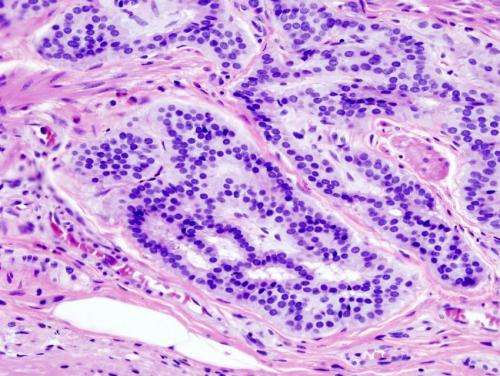Cancer—Histopathologic image of colonic carcinoid. Credit: Wikipedia/CC BY-SA 3.0
In a new study published in Cancer Epidemiology, Associate Professor Dr. Cara Frankenfeld of the George Mason College of Health and Human Services found racial disparities in how the presence of cancer-related diagnostic and treatment technology is related to colorectal cancer (CRC) patient outcomes in Georgia. The findings suggest that the hospital capacity and availability of advanced technologies may benefit white patients, but not black patients, in terms of time-to-treatment and overall survival.
The study, "Racial Disparities in Colorectal Cancer Time-to-Treatment and Survival Time in Relation to Diagnosing Hospital Cancer-Related Diagnostic and Treatment Capabilities," evaluated the time-to-treatment and survival rates of patients in relation to cancer-related technologies of the diagnosing hospital using colorectal tumor-level data from the Georgia Cancer Registry merged with hospital-level data from the American Hospital Association from 2010-2015. There were 11,453 colon tumors and 4,591 rectosigmoid/rectal tumors included in the analyses.
The study found that factors such as hospital capacity or size indicators (e.g., total surgical operations, licensed beds, and emergency room visits) were associated with earlier treatment in white patients, but not black patients. Higher counts of treatment related technologies were also associated with better survival for whites but not blacks. Despite disparities in other factors, availability of virtual colonoscopy technologies emerged as a technology related to survival favorability in both blacks and whites.
Researchers sought to better understand how structural issues at the hospital level influence differences in cancer outcomes across racial groups. Based on the data from the Georgia Cancer Registry, blacks experienced longer time-to-treatment and were less likely—at any point in time—to have received any treatment. Black patients also experienced longer time-to-surgery and longer time-to-treatment, respectively. However, the median time-to-treatment was similar across white and black patients.
These results suggest that characteristics of diagnosing hospitals influence overall treatment and survival but more work is needed to better characterize these influences and differences observed for white and black racial groups before specific recommendations to improve patient outcomes can be made. The study also provides an important foundation for future research in additional geographic locations.
"Structural influences on disease progression need further study, and this work contributes a piece to that complex puzzle," says Frankenfeld. "Understanding the long-term influences or consequences of where people get diagnosed with colorectal cancer and attempting to identify modifiable factors that benefit patients could be helpful to patients, as they think about CRC prevention and detection. Hospitals also benefit as they consider resource acquisition and utilization."
More information: Cara L. Frankenfeld et al, Racial disparities in colorectal cancer time-to-treatment and survival time in relation to diagnosing hospital cancer-related diagnostic and treatment capabilities, Cancer Epidemiology (2020). DOI: 10.1016/j.canep.2020.101684
Provided by George Mason University



















